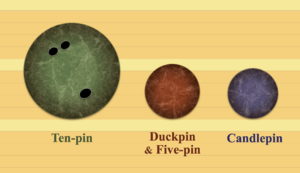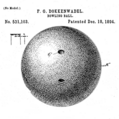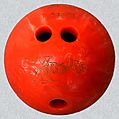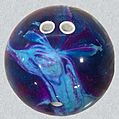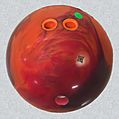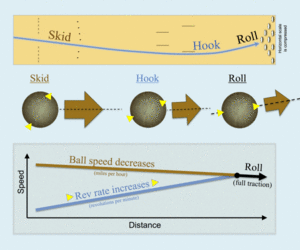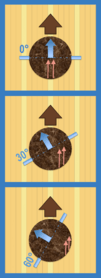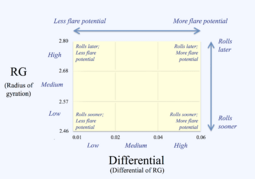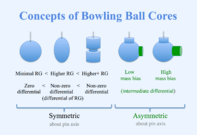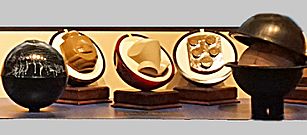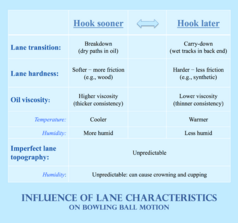Bowling ball facts for kids
A bowling ball is a hard, round ball used in the sport of bowling. Its main job is to knock down bowling pins.
Most bowling balls, especially for ten-pin bowling, have holes for two fingers and a thumb. But balls used in other types of bowling, like five-pin bowling, candlepin bowling, and duckpin bowling, are smaller and don't have holes. You hold them in the palm of your hand.
Contents
Ten-Pin Bowling Balls
What Are They Made Of?
Bowling balls have changed a lot over time. At first, they were made from a hard wood called lignum vitae. Then, in 1905, rubber balls came out.
In 1959, plastic balls were invented. Even though they didn't hook as much, they became very popular. By the 1980s, urethane balls were developed. These balls created more friction on the lanes, which made them hook more.
After urethane, reactive resin balls came along in the 1990s. These balls have tiny pores that soak up oil, making them "tacky" and giving them even more grip. Some reactive balls even have tiny particles (like glass or ceramic) mixed in to increase friction.
There are different types of reactive balls:
- Solid reactive balls have the most pores and grip.
- Pearl reactive balls have mica added, which helps them react better on drier parts of the lane.
- Hybrid reactive balls mix solid and pearl features.
- Particle balls have tiny particles for extra grip, especially on oily lanes.
Because modern balls hook so much, some bowlers still use plastic or urethane balls. They do this when they want less hook, like for certain spare shots.
How Balls Are Drilled
The way holes are drilled in a bowling ball is called its layout. This depends on where the ball's "pin" (a small marker) and "mass bias" (MB) are located. It also depends on the bowler's unique positive axis point (PAP), which is where the ball first starts to spin.
There are different ways to grip a ball:
- Conventional grip: Your fingers go in up to the second knuckle. This is common for "house balls" you rent at the alley.
- Fingertip grip: Your fingers only go in up to the first knuckle. This grip lets you put more spin on the ball.
- Some bowlers use a "two-handed delivery" but still release the ball with one hand. They often don't put their thumb in the ball. This allows their fingers to create even more spin.
Many bowlers use special inserts in the finger and thumb holes. These are custom-fit tubes, usually made of urethane, that help with grip and spin.
How Bowling Balls Move
A bowling ball's journey down the lane has three main parts:
- Skid: The ball slides over the oily part of the lane.
- Hook: As the ball hits drier parts of the lane, it starts to curve or "hook" towards the pins.
- Roll: The ball stops hooking and rolls straight towards the pins.
As the ball moves, its forward speed slows down. But its spin (or "rev rate") speeds up. When the ball hits the drier part of the lane, its side spin makes it hook. Eventually, the ball's spin matches its forward speed, and it enters the roll phase.
How Your Delivery Affects Ball Motion
How you throw the ball greatly affects how it moves.
- Ball Speed: A faster ball has less time to hook, so it hooks less. A slower ball has more time to hook.
- Rev Rate: More spin (higher rev rate) makes the ball hook earlier and more. Less spin makes it hook later and less.
- Axis Rotation: This is the side spin you put on the ball. A certain amount of side spin (usually 25 to 35 degrees) helps the ball hook the most.
- Axis Tilt: This is how much the ball is tilted sideways when you release it. More tilt means the ball touches the lane less, so it hooks less and later. Less tilt means more contact, leading to more hook earlier.
- Loft: This is how far past the foul line the ball lands. If you loft the ball further, it effectively shortens the lane, making the ball hook later.
How Ball Design Affects Ball Motion
The inside structure of a bowling ball, especially its core (also called "weight block"), and its outer surface (coverstock) also affect how it moves.
- Surface Finish: A "dull" (rough) ball surface grips the oily front part of the lane more, causing an earlier hook. A "gloss" (smooth) surface slides more on the oil but grips better on the dry back part, leading to a sharper hook later. There's no single "best" surface; it depends on the lane and bowler.
- Core Design: The shape and density of the core are very important.
* Radius of Gyration (RG): This tells you how the ball's weight is spread out. A higher RG means more weight is near the cover, making the ball hook later. A lower RG means more weight is near the center, making it hook earlier. * Differential of RG: This shows how much the ball wants to flare (change its axis of rotation). A higher differential means the ball can hook more sharply. * Intermediate Differential (ID): This measures how symmetrical or asymmetrical the core is. A higher ID means the core is more asymmetrical, which can make the ball react more quickly to friction.
Different coverstock finishes also affect how the ball moves:
- Matte: Very aggressive reaction, hooks early.
- Shiny: Skids longer than matte, hooks later.
- Pearl: Skids the longest among reactive coverstocks.
- Hybrid: A mix of skid and back-end reaction.
How Lane Conditions Affect Ball Motion
The bowling lane itself plays a big role in how the ball moves.
- Lane Transition: As balls roll down the lane, they pick up oil and move it around. This creates dry spots ("breakdown") and can spread oil to dry areas ("carry down"). Breakdown makes balls hook earlier, while carry down makes them skid longer and hook later.
- Lane Material: Older wooden lanes create more friction, so balls hook more. Newer synthetic lanes are smoother and create less friction, so balls hook less.
- Oil Viscosity: Thicker lane oil (higher viscosity) creates more friction, making balls hook more and slow down faster. Thinner oil is more slippery, allowing balls to go faster and hook less. Temperature and humidity can also change how thick the oil is.
- Lane Topography: Lanes are supposed to be flat, but they can have tiny bumps or dips. These small changes can make the ball move in unexpected ways.
Manufacturers
Many companies make bowling balls. The USBC keeps a list of approved bowling ball manufacturers and their balls.
Duckpin Bowling Balls
Duckpin bowling balls are smaller than ten-pin balls. They are about 4.75 to 5.00 inches (12.1 to 12.7 cm) wide and weigh between 3 pounds 6 ounces (1.5 kg) and 3 pounds 12 ounces (1.7 kg). They do not have finger holes. These balls are smaller to match the smaller size of duckpins. Sometimes, these balls are used in arcades for mini bowling lanes.
Five-Pin Bowling Balls
Five-pin bowling balls are very similar to duckpin balls. They are also about 4.75 to 5.0 inches (12.1 to 12.7 cm) in diameter and weigh between 3 pounds 6 ounces (1.5 kg) and 3 pounds 12 ounces (1.7 kg). Like duckpin balls, they don't have finger holes.
Candlepin Bowling Balls
Candlepin bowling balls are the smallest of all. They weigh between 2 pounds 4 ounces (1.0 kg) and 2 pounds 7 ounces (1.1 kg), and are only about 4.5 inches (11 cm) wide. This is much smaller than a ten-pin ball (8.5 inches (22 cm)) and even smaller than a duckpin ball (5.0 inches (13 cm)). Candlepin balls are lighter than the pins themselves, so they often bounce a lot when they hit the pins.
Images for kids
See also
 In Spanish: Bola de bowling para niños
In Spanish: Bola de bowling para niños


